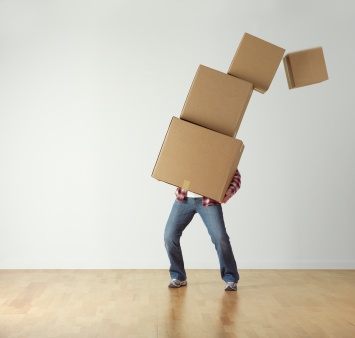Musculoskeletal Disorders (MSDs) are injuries and disorders of the muscles, nerves, tendons, ligaments, joints, cartilage and spinal discs. The symptoms of MSDs can include a dull aching sensation, discomfort with specific movements, tenderness to the touch, a burning sensation, pain, tingling, cramping or stiffness. Symptoms often appear gradually and may disappear during rest. The most common problems occur in a person’s neck, low back, shoulders, elbows, wrists and hands.

Primary Risk Factors
Being aware of your motions and movements that might cause problems is the first step to avoid doing something that may develop into an MSD. The four primary risk factors for MSDs include:
- Awkward or uncomfortable postures
- Using excessive force
- Repetitive motion
- Contact stress
Obviously, all these risk factors are amplified by how we lift and how we move our bodies. When we have a good understanding of how to avoid these risk factors, we can help avoid MSDs.
Maintaining Flexibility
One of the contributing factors to strains is when your body moves in ways it is not prepared to, or uses muscle groups that haven’t been warmed up for the task. Practicing some basic stretching exercises to prepare your body for work can help prevent strains or other serious injuries.
Simple stretching exercises for your hands, wrists, back and neck can help to avoid problems during the day. Hands and wrists should be stretched so they are ready to move in typical ways required at work. Your neck can be stretched gently from side to side and then from front to back. Your back can be stretched while sitting in a chair and bending so your chin gets close to your knees.
Lifting Techniques
How you lift and use your back muscles will determine if you are experiencing pain and troubles that can be avoided. Improper lifting will result in strains and pain. By following these lifting tips, you can avoid being hurt and having pain. No one can force you to lift the right way; you have to decide to use the proper techniques every time you lift.
First, when lifting, size up what is going to be lifted and determine if it is too awkward, too big or too heavy. If so, get some help from another worker. Too many times, workers have lifted items that were too big and the results were painful.
Second, always lift with your legs and never with your back. Many workers still lift with their backs instead of their legs because it requires less work at the time. But leg muscles can lift large loads without injury; the back cannot. When lifting, don’t bend at your waist; bend with your knees. Even lifting with your waist can cause lower back injuries.
Finally, when lifting, avoid lifting and twisting all in the same motion. Your first goal is to get what you are lifting up and then, once your legs are straight, you can move your legs instead of twisting your waist and lower back.
Rules of Good Lifting
Following these safe lifting rules will reduce the possibility of injury:
- Size up the load before lifting - test by moving a corner or pushing the load.
- Bend the knees when lifting - let your legs do the work.
- Place feet close to the object and center yourself over the load.
- Lift straight up in a smooth motion.
- Do not twist or turn your body once the lift is made.
- Make sure there is a clear path - this will help you avoid falling over something you can’t see.
- Set the load down properly.
- Always push a load that is on a cart - never pull it.
- If it is a long, awkward or extremely heavy object, get some help.
- Split the load into smaller loads, if possible.
Twisting, Reaching, Sideways Bending, Unequal Lifting
How you lift is very important, but twisting and reaching for objects can also cause strains. Any amount of twisting, reaching or bending while lifting causes more stress on the back. Here are some points to consider:
- Reaching upward: This usually causes the back to arch and increases the force on the lower spine. It also puts stress on the upper back, shoulders and arms.
- Forward reaches: Reaching beyond the length of your arms puts a lot of stress on your lower back.
- Bending and twisting concerns: Bending sideways or twisting your trunk puts stress on your lower back and increases the possibility of a lower back strain.
The possibility of causing a muscle strain increases when you don’t move properly and you do a lot of reaching, twisting, sideways bending, and unequal lifting or carrying.
Final Thoughts
Lifting and over-reaching are some of the main causes of musculoskeletal disorders. Pausing for a moment to make sure that you are lifting properly and not over-reaching will help to prevent strains. The Health and Safety Services available at Hausmann-Johnson Insurance can help you with any ergonomic questions or concerns that you may have.

COMMENTS